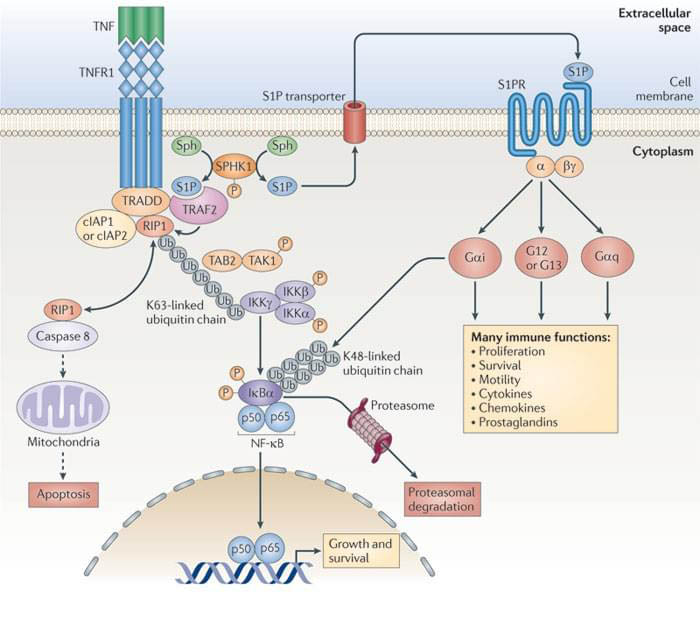Custom MemPro™ Services for Tumor necrosis factor receptor
Creative Biostructure provides custom gene-to-structure services for Tumor necrosis factor receptor.
Tumor necrosis factor receptors (TNFR) have a cysteine-rich domain to bind tumor necrosis factors (TNFs) to induce cell apoptosis and inflammation. It is a big family that contains 27 homologous family members which response to a variety of ligands. Additionally, despite their essential role in controlling acute and persistent infections, they are involved in other signal pathways through interaction with a variety of signal molecules including TRADD, TRAF, RIP and FADD. TNFR are expressed widespread in mammal tissues especially in leukocytes and lymph nodes. The disorder of TNFR will result in a lot of clinical diseases such as Familial Hibernian fever (FHF), multiple sclerosis 5 (MS5) and immunodeficiency 16 (IMD16).
 Figure 1. TNFR1 signal path
Figure 1. TNFR1 signal path
TWEAK (TNF-like weak inducer of apoptosis) and its receptor Fn14 (fibroblast growth factor-inducible immediate-early response protein 14) are one of the TNFR family which play predominant role in regulating tissue response induced by injured or disease. They are involved in a wide range of biological process including inflammation, lymphocyte survival as well as tissue regeneration and repair. Dysregulation of the TWEAK–Fn14 pathway under pathological conditions will activate non-canonical NF-κB pathway and may contribute to the amplification of an excessive inflammatory response, pathogenic angiogenesis and tissue remodeling, and inhibition of endogenous repair mechanisms
TNFR which expressed on T-cells named TNFR1A and TNFR1B have synonyms which refer to famous CD120a/b molecules. Their natural liagnd is TNF-α, also called cachectin. The binding mediates programmed cell death by activate the transcription factor NF-κB. TNFR1-activated NF-κB signal transduction is regulated by ubiquitin/proteasome system. TNFR1A/B can also interact with TRADD and TRAF to regulate a variety of downstream signal transduction.
Adalimumab, the best seller drug in 2015, is the first fully human monoclonal antibody approved by FDA that selectively binds to TNF-α to reduce inflammatory response of autoimmune diseases. It could be used for the treatment of rheumatoid arthritis, ulcerative colitis, plaque psoriasis, psoriatic arthritis, ankylosing spondylitis, juvenile idiopathic arthritis, Crohn's disease. However, since TNFRs play vital roles in controlling viral and latent infections, adalimumab may contribute to relapse of tuberculosis or HBV infections and the body might be vulnerable to new infections.
References:
Wertz I E. TNFR1-activated NF-κB signal transduction: regulation by the ubiquitin/proteasome system[J]. Current opinion in chemical biology, 2014, 23: 71-77.
Burkly L C. Regulation of Tissue Responses: The TWEAK/Fn14 Pathway and Other TNF/TNFR Superfamily Members That Activate Non-Canonical NFκB Signaling[J]. Frontiers in immunology, 2015, 6.
Migliore A. Long-term safety of anti-TNF adalimumab in HBc antibody-positive psoriatic arthritis patients: a retrospective case series of 8 patients[J]. Clinical and Developmental Immunology, 2013, 2013.